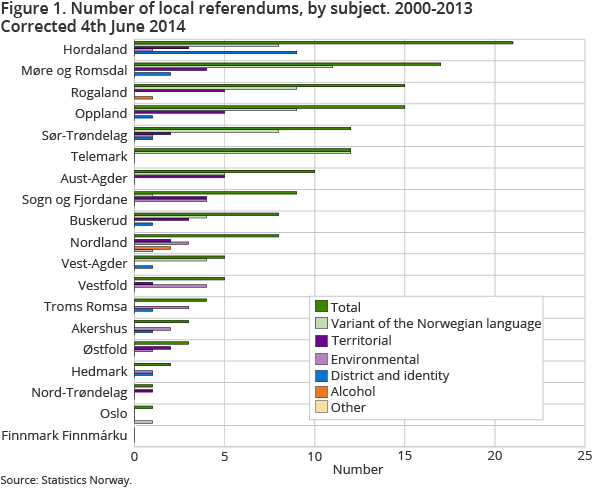Content
Published:
This is an archived release.
Referendums on Olympics, tax, language and municipal borders
Five local referendums were held in 2013. There were 501 035 eligible voters, and voter turnout was 66 per cent. The referendums related to the Winter Olympics in 2022, the Norwegian language variants, property tax and municipal boundaries.
| 2010 | 2011 | 2012 | 2013 | |
|---|---|---|---|---|
| Referendums | ||||
| Total | 16 | 13 | 8 | 5 |
| Alcohol | 0 | 1 | 0 | 0 |
| Variant of the Norwegian language | 9 | 2 | 3 | 2 |
| Territorial | 2 | 8 | 0 | 1 |
| District and identity | 2 | 2 | 0 | 0 |
| Environmental | 3 | 0 | 5 | 0 |
| Other subjects | 0 | 0 | 0 | 2 |

Statistics Norway has registered a total of 721 local referendums on various issues in the period 1970 to 2013. Voter turnout has varied, and has usually been lower than in general elections and municipal and county elections. The overall turnout in 2013 is the highest recorded since 1970, which is primarily due to a large turnout at the local referendum in Oslo.
Winter Olympics in Oslo
By far the largest referendum in 2013 related to whether Oslo should bid to host the Winter Olympics in 2022. The population of Oslo showed a keen interest in the issue, with 327 000 persons turning out to vote, which was a good 66 per cent of eligible voters. Around 175 000 of those who voted were in favour of Oslo holding the Winter Olympics, while around 142 000 were against. Approximately 9 500 of the approved votes were blank. The outcome was a 53.6 per cent majority in favour of holding the Games.
Norwegian language variant in Sauherad and Sel
Referendums were held in Telemark (Sauherad) and Oppland (Sel) on the written language variant to be used in primary and lower secondary schools. The results were considered by the respective councils within the end of the calendar year, and the outcome of the voting in both municipalities was upheld. Resolutions were therefore passed for primary and lower secondary schools in Sauherad to use Bokmål as the written language and to continue using Nynorsk as the written language in two school districts in Sel. There is traditionally a low voter turnout in referendums concerning the Norwegian language in schools, which was also the case in the Sauherad and Sel referendums. In Sauherad, voter turnout was below 15 per cent, while the figure in Sel municipality was slightly higher at 36 per cent of eligible voters.
In Arendal, a local referendum was held in 2013 concerning the transfer of Løddesøl district to Froland municipality. The population of Løddesøl district were given the opportunity to vote and turnout was good, at over 75 per cent, with a small majority voting in favour of the transfer.
In Lødingen municipality in Nordland, a referendum was held on the introduction of property tax. This referendum also saw a relatively large turnout, at 66 per cent. A large majority of 76 per cent opposed the property tax.
Most referendums about language
Of the 721 local referendums that have been registered since 1970, 43 per cent have related to Norwegian language variants and 25 per cent concerned alcohol. More recently, the number of alcohol-related referendums has fallen considerably. Since 2000, only 2 per cent of referendums have related to alcohol. During this period, referendums on language variants have continued, and even increased slightly, while territorial issues, i.e. mergers of municipalities, regulation of municipal boundaries and which municipal/county an area or town belongs to have become more dominant and now account for 26 per cent of all referendums. Environmental issues have also been more common since the 2000s.
Contact
-
Tove Bergseteren
E-mail: tove.bergseteren@ssb.no
tel.: (+47) 99 79 08 19
-
Statistics Norway's Information Centre
E-mail: informasjon@ssb.no
tel.: (+47) 21 09 46 42
-
Terje Risberg
E-mail: terje.risberg@ssb.no
tel.: (+47) 92 62 81 09
